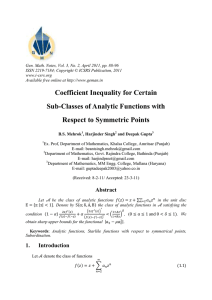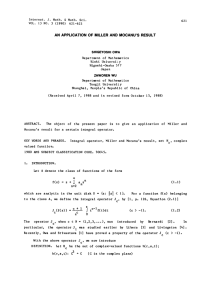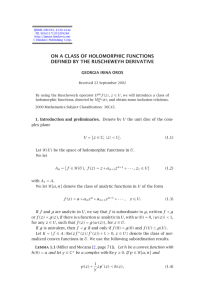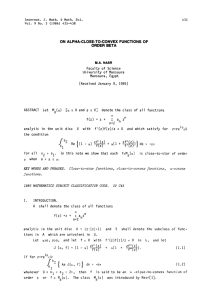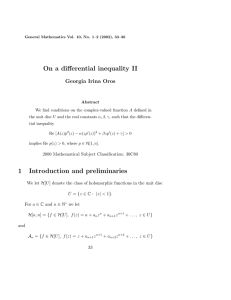A SUFFICIENT CONDITION FOR STARLIKENESS OF ORDER
advertisement
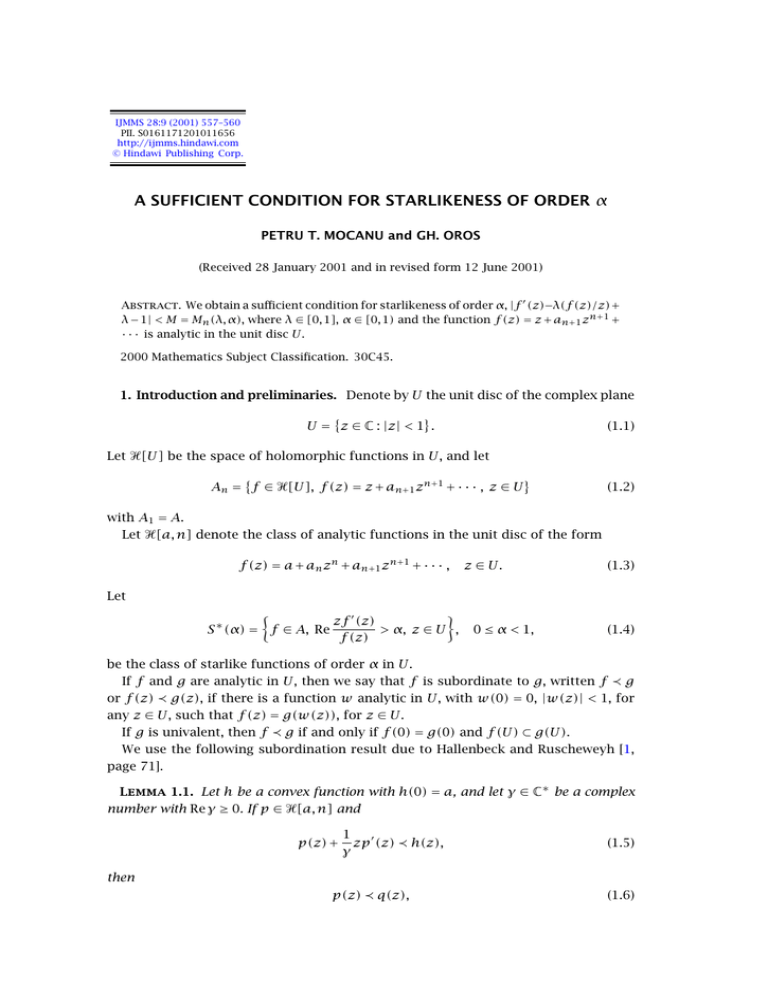
IJMMS 28:9 (2001) 557–560 PII. S0161171201011656 http://ijmms.hindawi.com © Hindawi Publishing Corp. A SUFFICIENT CONDITION FOR STARLIKENESS OF ORDER α PETRU T. MOCANU and GH. OROS (Received 28 January 2001 and in revised form 12 June 2001) Abstract. We obtain a sufficient condition for starlikeness of order α, |f (z)−λ(f (z)/z)+ λ − 1| < M = Mn (λ, α), where λ ∈ [0, 1], α ∈ [0, 1) and the function f (z) = z + an+1 zn+1 + · · · is analytic in the unit disc U. 2000 Mathematics Subject Classification. 30C45. 1. Introduction and preliminaries. Denote by U the unit disc of the complex plane U = z ∈ C : |z| < 1 . (1.1) Let Ᏼ[U ] be the space of holomorphic functions in U, and let An = f ∈ Ᏼ[U ], f (z) = z + an+1 zn+1 + · · · , z ∈ U (1.2) with A1 = A. Let Ᏼ[a, n] denote the class of analytic functions in the unit disc of the form f (z) = a + an zn + an+1 zn+1 + · · · , z ∈ U. (1.3) Let zf (z) S ∗ (α) = f ∈ A, Re > α, z ∈ U , f (z) 0 ≤ α < 1, (1.4) be the class of starlike functions of order α in U. If f and g are analytic in U , then we say that f is subordinate to g, written f ≺ g or f (z) ≺ g(z), if there is a function w analytic in U, with w(0) = 0, |w(z)| < 1, for any z ∈ U, such that f (z) = g(w(z)), for z ∈ U. If g is univalent, then f ≺ g if and only if f (0) = g(0) and f (U ) ⊂ g(U). We use the following subordination result due to Hallenbeck and Ruscheweyh [1, page 71]. Lemma 1.1. Let h be a convex function with h(0) = a, and let γ ∈ C∗ be a complex number with Re γ ≥ 0. If p ∈ Ᏼ[a, n] and p(z) + 1 zp (z) ≺ h(z), γ (1.5) then p(z) ≺ q(z), (1.6) 558 P. T. MOCANU AND GH. OROS where q(z) = γ nzγ/n z h(t)t γ/n−1 dt, 0 q ≺ h. (1.7) 2. Main results Theorem 2.1. Let λ ∈ [0, 1], α ∈ [0, 1), and M = Mn (λ, α) = (1 − α)(n + 1 − λ) . |λ − α| + (1 − λ)2 + (n + 1 − λ)2 (2.1) If f ∈ An satisfies the inequality f (z) − λ f (z) + λ − 1 < Mn (λ, α), z (2.2) with Mn (λ, α) given by (2.1), then f ∈ S ∗ (α). Proof. In the case λ = 1, the proof is given in [3]. We suppose that λ ∈ [0, 1). If we consider P (z) = f (z)/z, then f (z) = P (z) + zP (z), f (z) = zP (z), (2.3) and (2.2) can be written in the following form: P (z) + zP (z) − 1 < M 1−λ 1−λ (2.4) which is equivalent to the differential subordination P (z) + M zP (z) ≺ 1+ z ≡ h(z), 1−λ 1−λ (2.5) and by using Lemma 1.1, we obtain P (z) ≺ q(z) = γ nzγ/n z 0 h(t)t γ/n−1 dt = 1 + M z. 1−λ+n (2.6) Subordination (2.6) is equivalent to P (z) − 1 < M ≡ R. 1−λ+n (2.7) After a simple computation, from (2.7) it follows that R< If we put then 1−α . |λ − α| zf (z) = (1 − α)p(z) + α, f (z) f (z) = P (z) (1 − α)p(z) + α (2.8) (2.9) (2.10) A SUFFICIENT CONDITION FOR STARLIKENESS OF ORDER α 559 and (2.2) can be written as P (z) (1 − α)p(z) + α − λ + λ − 1 < M = (1 − λ + n)R. (2.11) We have to show that (2.11) implies Re p(z) > 0 in U. Suppose that this is false. Since p(0) = 1, there exist z0 ∈ U and a real ρ, such that p(z0 ) = iρ. Therefore, in order to show that (2.11) implies Re p(z) > 0 in U , it is sufficient to obtain the contradiction from the inequality P z0 (1 − α)p z0 + α − λ + λ − 1 ≥ (1 − λ + n)R. If we let P (z0 ) = P = u + iv, then 2 E = P (1 − α)iρ + α − λ + λ − 1 = |P |2 (1 − α)2 ρ 2 + (α − λ)2 − 2(1 − λ) Re P (1 − α)iρ + α − λ + (1 − λ)2 2 = u2 + v 2 (1 − α)2 ρ 2 + 2(1 − λ)(1 − α)vρ + P (α − λ) − (1 − λ) . By using (2.7) and the well-known triangle inequality, one obtains P (α − λ) − (1 − λ) = P (α − λ) + α − λ − α + λ − 1 + λ = (α − λ)(P − 1) − (1 − α) (2.12) (2.13) (2.14) ≥ 1 − α − |λ − α|R and we deduce 2 E ≥ u2 + v 2 (1 − α)2 ρ 2 + 2(1 − λ)(1 − α)vρ + (1 − α) − (λ − α)R . (2.15) If we let F (ρ) = E − M 2 ≥ u2 + v 2 (1 − α)2 ρ 2 + 2(1 − λ)(1 − α)vρ 2 + (1 − α) − |λ − α|R −(1 − λ + n)2 R 2 , (2.16) then (2.12) holds if F (ρ) ≥ 0, for any real number ρ. Because (u2 + v 2 )(1 − α)2 > 0, the inequality F (ρ) ≥ 0 holds if the discriminant ∆ is negative, that is, 2 ∆ = (1 − α)2 (1 − λ)2 v 2 − u2 + v 2 1 − α − |λ − α|R − (1 − λ + n)2 R 2 ≤ 0. (2.17) The last inequality is equivalent to 2 v 2 (1 − λ)2 − 1 − α − |λ − α|R + (1 − λ + n)2 R 2 ] 2 ≤ u2 1 − α − |λ − α|R − (1 − λ + n)2 R 2 . (2.18) After an easy computation, by using (2.7) we obtain the inequality 2 1 − α − |λ − α|R − (1 − λ + n)2 R 2 v2 R2 ≤ ≤ , 2 u2 1 − R2 (1 − λ)2 − 1 − α − |λ − α|R + (1 − λ + n)2 R 2 (2.19) which is equivalent to ∆ ≤ 0. Therefore F (ρ) 0, a contradiction of (2.11). It follows 560 P. T. MOCANU AND GH. OROS that Re p(z) > 0, and Re zf (z) = Re(1 − α)p(z) + α = (1 − α) Re p(z) + α ≥ α f (z) (2.20) hence f ∈ S ∗ (α). If λ = 0 then Mn (0, α) = (1 − α)(n + 1) α + (n + 1)2 + 1 (2.21) and we obtain the following corollary. Corollary 2.2. If f ∈ An and f (z) − 1 < (1 − α)(n + 1) , α + (n + 1)2 + 1 (2.22) then f ∈ S ∗ (α). For α = 0 this result was obtained in [2]. If λ = 1, Mn (1, α) = n(1 − α) , n+1−α (2.23) and we obtain the following corollary. Corollary 2.3 (see [3]). If f ∈ An and f (z) − f (z) < n(1 − α) , z n+1−α (2.24) then f ∈ S ∗ (α). If λ = α, Mn (α, α) = (1 − α)(n + 1 − α) . (1 − α)2 + (1 − α + n)2 Corollary 2.4. If f ∈ An and f (z) − α f (z) + α − 1 < (1 − α)(n + 1 − α) , z (1 − α)2 + (1 − α + n)2 (2.25) (2.26) then f ∈ S ∗ (α). References [1] [2] [3] S. S. Miller and P. T. Mocanu, Differential Subordinations: Theory and Applications, Monographs and Textbooks in Pure and Applied Mathematics, vol. 225, Marcel Dekker, New York, 2000. MR 2001e:30036. Zbl 0954.34003. P. T. Mocanu, Some simple criteria for starlikeness and convexity, Libertas Math. 13 (1993), 27–40. MR 94k:30027. Zbl 0793.30008. G. Oros, On a condition for starlikeness, The Second International Conference on Basic Sciences and Advanced Technology (Assiut, Egypt, November 5–8), 2000, pp. 89–94. Petru T. Mocanu: Department of Mathematics, Babes-Bolyai University, 3400 ClujNapoca, Romania E-mail address: pmocanu@math.ubbcluj.ro Gh. Oros: Department of Mathematics, University of Oradea, 3700 Oradea, Romania





